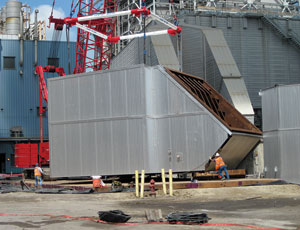A$400-million wet flue gas desulfurization (FGD) project now under way at the Fayette Power Project near La Grange, Texas, will remove about 97% of sulfur dioxide emissions from the plant's two units and allow the 1,200-MW facility to meet permitting obligations.

Above: Moving Into Place
Contractors move a duct section made of carbon steel into position for final placement. Separate sections of this type of ductwork tie into existing chimneys.
Top: Power to the people
Lower Colorado River Authority and Austin Power Energy are spending $400 million to add scrubbers at the Fayette Power Plant in Texas.
“We are interested in redundancy and reliability, and we designed this system for 30-plus years of services,” says Gregor Forbes, chief project manager for the Lower Colorado River Authority (LCRA), co-owner of the two 600-MW units along with Austin Power, a municipal utility.
The new scrubber system employs ground limestone and water sprayed into vessels containing the gas. “The limestone and moisture attract the SO2 molecule particles, and they are captured and collected,” Forbes adds. “The limestone slurry makes its way back to the vacuum-filter building, which is where the byproduct ends up. We extract a certain amount of moisture, and the byproduct is sold.” He says the byproduct is used to manufacture masonry block and wallboard, while about 20% to 25% of the mercury created by the two units is also removed.
Burns & McDonnell, Kansas City, Mo., engineered the FGD project, while Houston-based general contractor KBR is installing two wet scrubbers manufactured by Toronto-based Marsulex.
Many Design Factors
The desulfurization system kicks on before the boiler to immediately collect any gas; it continues running after the boiler shuts down to ensure capture of all vapors. The scrubber on Unit 1 came on line in January and is exceeding the 97% target for removing SO2.
Units 1 and 2 are receiving the same scrubber system already in place on Unit 3. LCRA considered other technologies such as a dry limestone system, but by using the same system, the company could share some of the infrastructure, Forbes says.
Material costs influenced scrubber design, Forbes says. When exotic alloy prices spiked during the project design phase in 2004 and 2005, the team decided to use fiberglass-reinforced plastic for the flue liners.
“Fiberglass reinforced plastic liners also have the advantage of being manufactured and installed in full cylindrical sections, so they can be installed quicker than an alloy liner, which is typically constructed in the bottom of the chimney in smaller segments,” says Scott Richart, lead project structural engineer for Burns & McDonnell. “Fiberglass reinforced plastic liners are the most utilized liner system for new chimneys at coal-fired utilities operating under wet FGD conditions.”
The vessels have a carbon steel exterior. LCRA and Burns & McDonnell initially considered lining the vessels with a C276 nickel alloy but decided on a corrosion resistant tile manufactured and installed by Stebbins Engineering and Manufacturing, Watertown, N.Y., which has a track record of servicing other facilities.
“In selecting the Stebbins tile lining for the absorber vessels, we needed to consider the design chloride concentration of the FGD system, material costs and availability, manpower availability, allowable wastewater treatment system configurations and any other owner preferences,” Richart says.
LCRA imbedded quality inspectors during fabrication of major components to oversee the work and ensure it complied with the engineers' specifications. Some components came from China, which raised concerns about delays, but all equipment arrived on schedule, Forbes says. Inspectors were on site during fabrication of flue-gas absorber components design installation by the general contractor, Forbes says. “That helps get away from finger pointing,” he notes.
Scrubber installation took place during plant operation. “We constructed the absorber island independent of the boilers; ductwork ties it together,” Forbes says. Crews will then connect the existing boilers into the new system. The project required construction of a new chimney with two flues. It includes built-in safety guillotine dampers, fans and quench headers that can seal off high temperature gases that could occur with a high-megawatt trip from the boilers. The designers retained the existing chimneys as alternative gas paths.
Construction included an electrical building with switchgear and electronics, a shared services building and an additional ball mill to grind the limestone, which runs about 22 hours a day.
An oily-waste system pulls oil out of any water that runs off equipment before disbursing to retention ponds. Crews also installed curbs and lined trenches to ensure the discharge would not run off site.
Fayette's three coal-fired units supply enough power to serve about 1 million Central Texas residents. The U.S. Energy Information Administration says it is the 75th-largest electric plant in the country in terms of net generation. Units 1 and 2 were installed in 1979 and 1980. LRCA, which owns Unit 3, says the plant primarily uses coal from the Powder River Basin in Wyoming, which the utility says burns cleaner than other types of coal.
Article toolbar
Post a comment to this article
Report Abusive Comment